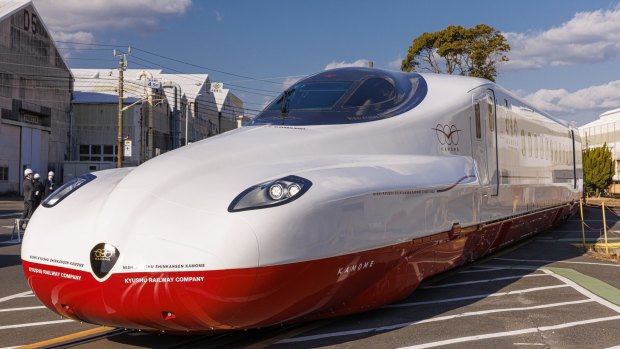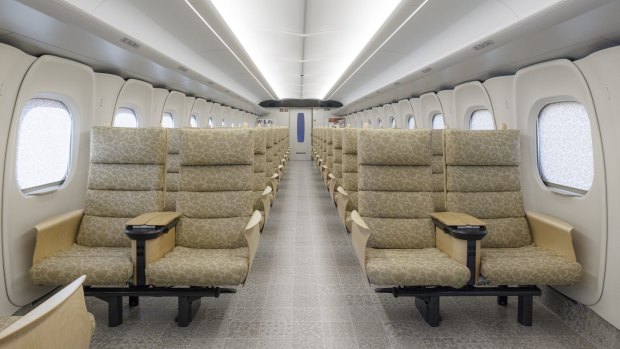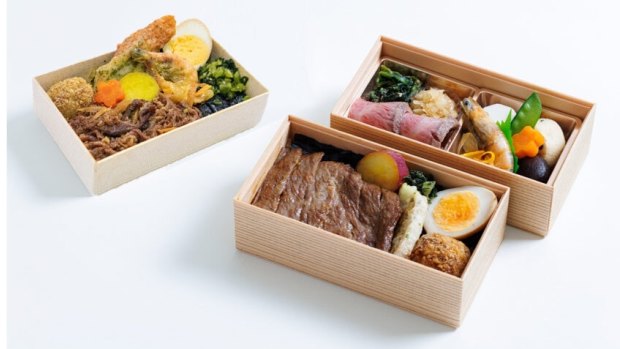This was published 1 year ago
Nishi Kyushu Shinkansen Line, Japan: New bullet train route is Japan's shortest
By Ute Junker

The new Class N700S Shinkansen runs on the Nishi Kyushu line.
For many travellers to Japan, a trip on a Shinkansen, or bullet train, is an adventure in itself. The super-fast trains, which travel at speeds of up to 300 kilometres per hour, are often the most efficient way to travel between major cities, and a two- or three-hour bullet train trip is an opportunity to relax and catch up on emails, and an excuse to tuck into one of the bento box meals sold at every station.
If you are travelling on Japan's newest Shinkansen line, however, you may need to rethink your lunch plans. The Nishi Kyushu Shinkansen Line between Takeo-Onsen in Saga Prefecture and the city of Nagasaki is only 66 kilometres long, and the entire trip takes just 23 minutes.
The new route, which launched on September 23, is operated by Kyushu Railway (JR Kyushu). The second Shinkansen line on Kyushu, it is the shortest Shinkansen line in Japan. A test drive prior to launch attracted a local media contingent of 140 people keen to report on the innovations of the train called Kamome, or "seagull".

Although the new line only covers a short distance, there are hopes it will help increase tourism to Kyushu.
The new Class N700S Shinkansen has a more aerodynamic design that produces seven per cent less energy than previous models and has improved braking. It also has lithium-ion batteries which can be used in earthquakes and other emergencies, so the train can continue to the nearest station without overhead power, as well as sleek interiors by veteran industrial designer Eiji Mitooka.
Kamome features three reserved seating carriages and three carriages with unreserved seating, and travels at speeds up to 260 kilometres per hour. Passengers can celebrate their trip by purchasing a wide range of omiyage, or souvenirs – from beer to cakes to Bandaids - many emblazoned with the phrase, "Come on Kamome".
There are plans to extend the Nishi Kyushu Shinkansen line to connect with the existing Kyushu Shinkansen line, although no timeframe for the project. It is common to build Shinkansen lines in stages, given the complex funding negotiations between national and local governments.

The train features three reserved seating carriages and three carriages with unreserved seating.
Japan's Shinkansen network has become a symbol of the country since launching 58 years ago in time for the 1964 Tokyo Olympics. The system carries 477,000 passengers a day – around 6.5 billion since it launched almost 60 years ago – with an average delay of less than a minute. Reportedly, there has not been a single fatality on the network due to a crash or derailment during that time.
The Shinkansen network is credited with helping boost local economies. When the Kyushu Shinkansen line was opened in 2011, economic growth in Kagoshima Prefecture at the southern tip of Kyushu, 1200 km away from Tokyo, was estimated at more than 46 billion yen ($A490 million).
Shinkansen trains also help drive tourism. Although the new line only covers a short distance, Kyushu Tourism manager Simon Metcalfe is hopeful that it will help raise awareness about Kyushu as a destination.

Passengers can purchase bento boxes featuring local delicacies such as Saga beef and Ariake Sea seaweed on board.
"People know about Nagasaki and its history but there is so much within this one island, from hot springs to islands with beautiful beaches," he says.
Australians planning to visit Nagasaki also have the option of taking the slow route. A new sightseeing train, the Futatsuboshi 4047, travelling between Takeo-Onsen and Nagasaki, launched on the same day as Kamome (the name translates as "Two Stars", those stars being the Saga and Nagasaki prefectures).
Also designed by Eiji Mitooka, the train trip takes a leisurely three hours, giving guests plenty of time to gaze out of the large windows and enjoy bento boxes featuring local delicacies such as Saga beef and Ariake Sea seaweed. The train operates daily from Friday to Monday.
Shinkansen fans have another launch to look forward to: Japan's first magnetic-levitation train, due to start operating on the Chuo Shinkansen line in 2027. Travelling at up to 600 kilometres per hour, largely underground, the new train will reduce the travel time between Tokyo and Nagoya from 100 minutes to just 40.
Prices for the train from Hakata (Fukuoka) and Nagasaki start from 3600 yen ($A39, pre-booked seat, at least three days in advance).
The writer travelled as a guest of Kyushu Tourism.
See also: Japan is back: Aussie favourite to finally reopen without restrictions
Sign up for the Traveller Deals newsletter
Get exclusive travel deals delivered straight to your inbox. Sign up now.